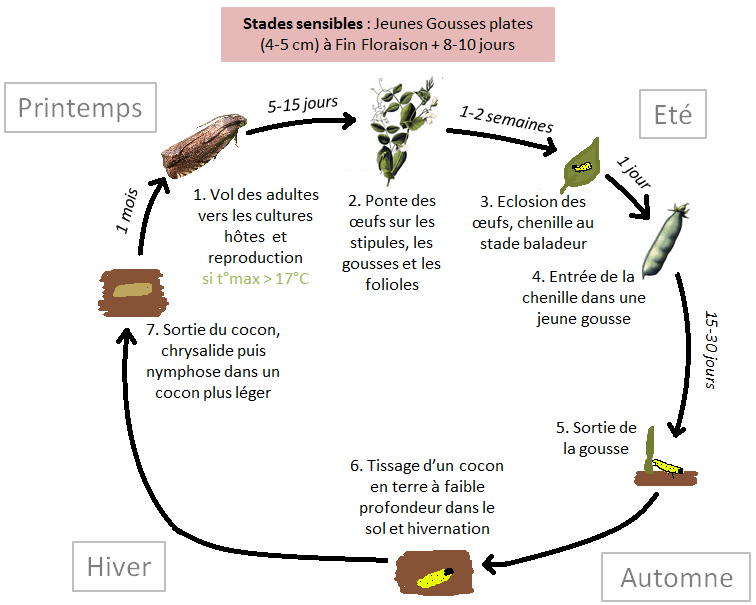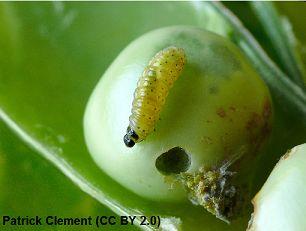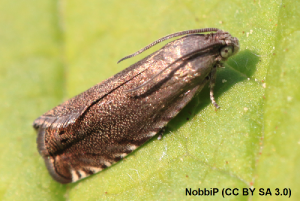Pea moth
1. General description
| Scientific name | Cydia nigricana (syn. Lapeyresia nigricana) |
| Classification | Order Lepidoptera, family Tortricidae |
| Geographical range | Present in the northern half of France |
| Crops affected | Peas, vetches, clovers, lentils |
2. Biology and epidemiology
Biological cycle

Conditions favourable to development
| Environment | The adult seeks out unventilated areas with dense vegetation. |
| Climate | Wind and cold hamper the activity of adults, whose flight is very limited at maximum temperatures below 18°C. Damage is greatest in the warmer months of June. |
| Cultivation history of the plot | Late pea varieties are the most affected. |
| Plot environment |
3. Damage
Symptoms and damage
On peas, each caterpillar damages up to 6 seeds, but only 1 or 2 are severely eaten away (cf. photo below, partially nibbled appearance different from the round holes caused by bruchids). The damage occurs mainly at high fruiting levels: it is therefore the caterpillars from the late flights that are damaging and which must be destroyed before they penetrate the pods.
The budworm causes little yield loss, but can moderately affect the germinative capacity of the seeds. In addition, lots of peas intended for human consumption (yellow peas or peas for canning) may be rejected if they contain seeds gnawed by caterpillars.

Measuring systems
On peas, chemical control is triggered by following the Bulletins de Santé du Végétal (Plant Health Bulletins) or on the basis of the number of moths caught using a sex trap placed in the plot at plant height at the start of flowering. There are currently two thresholds :
1) For food and seed production : 100 cumulative captures and appearance of the first flat pods on the peas. If flights persist, repeat the treatment every 8-10 days until 4 levels of pods have reached the Abortion Limit Stage (around 8-10 days after the end of flowering).
2) For animal feed : 400 cumulative captures and appearance of the first flat pods. The treatment should be repeated if the 400 cumulative captures threshold is reached again.
On lentils, the harmfulness threshold is greater than 800 cumulative captures in a plot since the appearance of the first pods.
Pests
(to be completed)
4. Management methods
Measures upstream of the crop
Use early pea varieties, which are less attacked than late varieties.
Catch-up solutions
| Type | Description | Effectiveness |
| Chemical control | Application of pyrethroid | Effective on caterpillars at the crawler stage, before they enter the pods
|
Innovative solutions
/
5. To go further...
| Title | Type of document | Year | Authors | Publishers | Précisions |
|---|---|---|---|---|---|
| e-phytia page : pea leafroller | Website | 2017 | INRA | INRA | link vers le site |
| ABAA database : pea leafroller | Website | 2017 | EcophytoPIC | ACTA | link to the website |
| Pea leafroller | Website | 2017 | Terres Inovia | Terres Inovia | link to the website |
| Pea leafroller | Website | 2017 | Arvalis - Institut du végétal | Arvalis - Institut du végétal | link to the website |
| Pea leafroller (Cydia nigricana) | Technical brochure | / | DRAAF Centre Val de Loire | DRAAF Centre Val de Loire | link to brochure Detailed information on setting up traps |
| The 5 lentil pests | Technical brochure | / | Haute-Loire Chamber of Agriculture, Groupement des producteurs de la lentille verte du Puy | Haute-Loire Chamber of Agriculture | link to the brochure |
| Lentil, an ancient crop for modern times. | Book | 2007 | P. Sevenson, M. Dhillon, H. Sharma, M. El Bouhssini | Springer Netherlands | Chapter 20 : Insect pests of lentil and their management (pp 331-348) |
Appendices
S'attaque aux cultures
